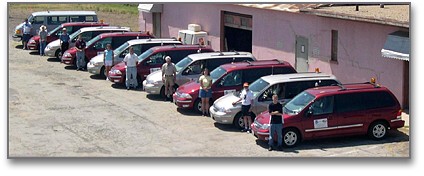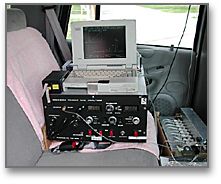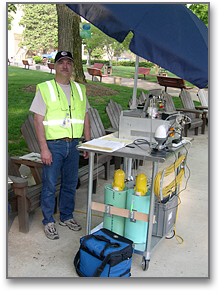Atmospheric Tracer Technology -- Real-time Analyzers
The real time SF6 analyzers are built around the modified TGA-4000 Tracer Gas Analyzers built by ScienTech Inc.
They use an electron capture detector (ECD) to detect SF6 in the sample stream. This requires that the
oxygen (which interferes with the ECD operation) be removed from the sample prior to introducing it into
the ECD. This is done by reacting the oxygen with hydrogen in a catalytic reactor and removing the
resultant water with a semi-permeable membrane.
Measurement Characteristics
- Limit of Detection: minimum of about 10 ppt, but varies depending on range analyzer is set up for. (ppt=parts per trillion by volume)
- Limit of Quantitation: minimum of approximately 30 ppt
- Maximum Concentration: 10,000 ppt (may be extended to 20,000 ppt with a dilution system)
Space Requirements
The system can be installed on a lab cart (3'x2.5'x4') or in a vehicle. When installed in a vehicle,
two standard passenger seats are required (one for the analyzer and the other for the compressed
nitrogen tank), plus space for the calibration module. The nitrogen tank and analyzer are fastened
in with seat belts and the calibration module typically sits on the vehicle floor by the analyzer.
Space is also needed for an operator and a few supplies in the vehicle. These
should fit in most automobile and aircraft seats. Mounting may be adapted for other vehicles.
Power Requirements
The system requires approximately 4 amps at 12 volts or 1 amp at 110 volts AC. For automobiles, this is typically provided
by tapping into the cigarette lighter circuit. For vehicles not providing 12 volts, AC inverters, batteries, or other
power sources may be used.
Chemicals Carried With the System
- Compressed hydrogen in a small aluminum cylinder approximately 12 inches tall and 3 inches in diameter. Maximum
pressure is 1,500 psi with an approximate equivalent volume of 127 liters.
- Compressed nitrogen in an aluminum cylinder approximately 16 inches tall and 6 inches in diameter. Maximum
pressure is 2,000 psi with an approximate equivalent volume of 800 liters.
- In some installations, compressed air in an aluminum cylinder approximately 16 inches tall and 6 inches in diameter.
Maximum pressure is 2,000 psi with an approximate equivalent volume of 800 liters.
- Methanol for cleaning purposes. Approximately 500 ml in a Nalgene bottle.
Other
An operator is required to accompany the analyzer during experiments to monitor its operation and identify
SF6 peaks. For accurate measurements, it is recommended that the analyzer move away from the SF6 plume
to establish baseline and run calibrations every two hours. The ECD requires cleaning once every 24 hours.

FRD vans, outfitted with real-time sampling systems, prepare for a test.
|
 |

FRD's real time sampling system easily fits in the back seat of an SUV and can be powered by the
vehicle's cigarette lighter circuit. It is extremely sensitive
and can detect the presence of SF6 down to 10 parts per trillion. This makes it capable of
detecting the tracer gas many miles from the release point (actual distance depends on tracer release rate,
wind speed and other factors).

Real-time analyzer deployed on a lab cart in the Pentagon's courtyard.
|

